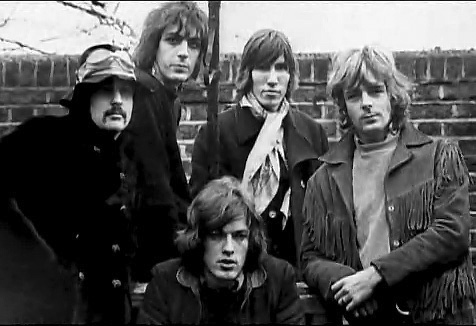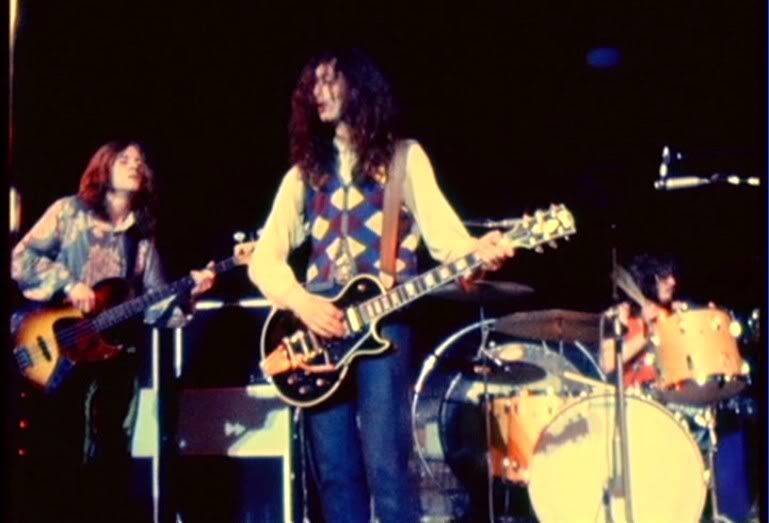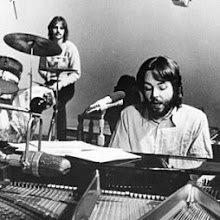When disscussing Eric Clapton's first solo album in my last post, I resisted temptation to go off on a long tangent (since it would have little/nothing to do with Delaney Bramlett.) But today, I think the time is right.
While on tour with Delaney & Bonnie, Clapton became good friends with the musicians. They would go on to work with him on his solo disc, and some would play with him as he worked on Harrison's "All Things Must Pass" album. Three musicians in particular became close to Clapton: drummer Jim Gordon, keyboardist Bobby Whitlock, & bassist Carl Radle. During the "All Things Must Pass" sessions, in addition to working on proper songs, their were many jams. 3 of the 4 jams released on the third disc of the record featured all of them playing together. It was through these jams that they became pretty tight, and as Harrison worked on his album, they decided to do a single.
Harrison played on both sides, and Phil Spector took production credit (though one can not be sure he ever heard the record), and the musicians recorded "Tell The Truth," and "Roll It Over." The single was a complete flop. But that made no matter. These musicians had a name now, Derek and The Dominos, Clapton's attempt to shield himself from his fame a bit, to start off fresh. They had first used the name for their first concert (which featured Dave Mason, who was slated to be a member, but never again played with the group.) The audience was briefly fooled into thinking it was an unknown group (Eric Clapton & Friends had been on the bill, so these Dominos sounded like a possible opening act.) It was not long before the crowd realized what was going on, a burst into applause and cheers. More shows would follow, all small scale, perfect oppurtunities to tighten up as a group.
"Tell The Truth" is now a popular Clapton song, but it is not the single arrangment that the Slowhand does in concert. This one had a very fast pace, and a pop vibe. When later working on their album, the band did a slow jam version of "Tell The Truth." This instrumental was sped up (though still not at all fast), while the vocals were taken from the single, and slowed down, making a mix of two takes for the release. The jam version was released as early as 1972 on a Clapton compilation, and later re-released with other session outtakes.
So, with a single completed, much practice garnered from their shows, and obligations to Harrison's album completed, Derek & The Dominos moved on to work on their album.
The album would be called "Layla & Other Assorted Love Songs." The driving theme of the record was Clapton's forbidden love of Harrison's wife, Pattie Boyd. The song "Layla" was the most striking realization of this theme, and Clapton had actually played a rough mix of it for Patti, who knew exactly what it was about. Clapton would wind up marrying Boyd.
Trouble with romance was not Clapton's only problem. He was still trying to shake his image of guitar God, still nervous about singing, and was getting into heavier drugs like heroin. His problems would soon lead him into a period of isolation, but before this happened, Clapton worked with the Dominos.
Aside from Clapton, the band was American, and took to Miami to cut a record. While working on the album, Clapton heard The Allman Brothers were going to play in Miami. Clapton was excited to attend the show, as he was very much enthralled by what he had heard of the young guitarist Duane Allman. He sat front row, and when Duane saw him, he could not help but stop playing, in awe that he was able to attract Eric Clapton in the audience. Afterwards, Clapton jammed with the Allman Brothers Band, and Duane was given the oppurtunity to work on the sessions a bit. However, once he began working on the album, his work proved so fantastic that he was promoted from a session worker to a full member, and laid down tracks for nearly every song.
Clapton & Whitlock were the main writers for the album. The had put together a catalogue of songs before they began working on "All Things Must Pass." Their were also a good number of cover songs. All the songs, however, carried the same sort of vibe, mixing an urgency with a laid-back, struggling sense of carrying the weight of the world. (Clapton would give into the second one, briefly retreating from the world not long after this album.)
The album was a flop. Like the single, nobody knew this was Clapton (his name only appeared on the back of the record.) The album would be a hit only after the album "The History Of Eric Clapton" came out in '72. This album covered Clapton's career from the Yardbirds up to the Dominos. The last side of this double record carried the single and jam takes of "Tell The Truth", and closed with "Layla." Now that Clapton was associated with the song, a demand for a single arose, and with it the success that the song had missed a year and a half earlier.
Anyway, after the album, Derek & The Dominos did a US tour (minus Allman, who went back to the ABB, although did manage to rejoin for two shows.) It was full of drugs and the like, but all the same was well recieved. The tour was first recounted in '73 on "In Concert," a live album taking from two Fillmore shows. Later, in '94, a CD "Live At The Fillmore" was released, copying most of "In Concert" ("Let It Rain," "Tell The Truth," and "Why Does Love Got To Be So Sad" from "In Concert" were replaced with different versions), and adding more songs from the Fillmore shows. The tracklisting is great, pulling together songs from Clapton's eponymous album, the "Layla" album, "Presence of The Lord," the solo Blind Faith number that Clapton wrote, plus Clapton's signature, "Crossroads." Many songs turned into extended instrumentals, great displays of Clapton's virtousity. The singing still showed a nervous Clapton, who rarely sang without Whitlock sharing the vocals, less as a back up singer than simply shielding Clapton.
Critics of the album often site the fact that it was their first big show, and that their was markable improvement over the course of the tour. However, the sound quality of later shows is suspect, and for that reason, have not been released.
The band went downhill after the tour. Clapton was already hurt by the fact that Jimi Hendrix had died (the Dominos had covered his "Little Wing" days before hearing the devestating news.) Coupled with Allman's death from a motorcycle accident, Clapton began fearing his own demise. He was also hurt by reviews of the Dominos' work, since he was hoping to build in this a new image, and seemed to be failing. Finally, he was wrapped up with Pattie Boyd, and felt he was simply using Derek and The Dominos as a rouse, as disguise to wear as he stole Pattie, her disguise being "Layla." It was all very trying on his weakening psyche (no doubt also damaged by the drug use) and finally, the band was dissolved, whilst attempting a second LP.
That second LP remains unfinished, but Clapton has opened the vaults to those sessions, releasing 5 songs from them on his "Crossroads" Box.
Also, in 1990, the sessions for the "Layla" album saw the light of day on the "Layla Sessions" box. In addition to a remixed album, there was a disc of jams, and a disc of unfinished songs and alternate takes. Sadly, this box proved a bit dissapointing, as little material really proved necessary to release, most of it below the standard of quality set by the proper album. Still, it proved a fun look at the band.
To own everything official by the Dominos, one needs their first album, "Layla", which can be bought along with the disc of jams and the disc of outtakes by getting the "Layla Sessions" set, the box set "Crossroads," which has "Evil," "Got To Get Better In A Little While," "Snake Lake Blues," "Mean Old Frisco," & "One More Chance," 5 songs from the unreleased second album, plus the "Tell The Truth/Roll It Over" single, "Live At The Fillmore," and for the three other live songs mentioned earlier, "In Concert." ("In Concert" might be rare now, but is worth tracking down as its' versions of "Let It Rain," and even more so "Why Does Love Got To Be So Sad" are better than the ones on "Live At The Fillmore.")
Clapton returned from his depressed and isolated state after Pete Townshend got him out, and did the famous "Rainbow Concert." By this point, "Layla" was famous. Things began to turn around for him. The drugs were still there, and his marriage to Pattie proved ultimately unsuccessful (they were married from '79 to '88.) But he would even overcome those issues in time.
Saturday, March 28, 2009
Subscribe to:
Post Comments (Atom)


















No comments:
Post a Comment